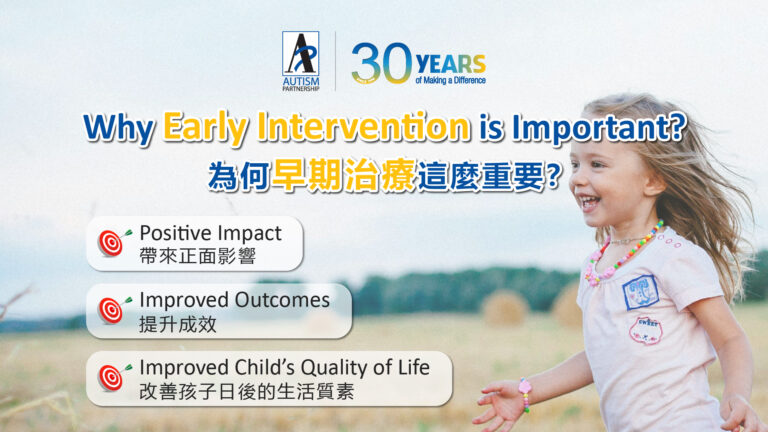
 To prevent or stop a child talking to himself, probably the fastest way is to direct the child to engage in an incompatible behaviour like drinking or eating. But just like any other disruptive behaviours, the most effective and long-term solution to self-talking is to teach replacement skills.
If a child with ASD often talks to himself when he is not engaged, it is likely that the behaviour serves the function of killing boredom. The best way to manage the behaviour is to teach the child age-appropriate play skills, increase his interests to easy-to-access toys and activities, and to learn how to occupy his time independently. At a more advanced level, an individual may need to learn to be aware of the current social setting and to identify what is the more appropriate way to spend his free time. For example, in a classroom where students are engaging themselves quietly, our student should be able to notice the atmosphere and pick an activity that does not cause disturbance to the surroundings.
A child may tend to talk to himself during lessons. The active engagement in self-talk and the avoidance to participate in class or therapy suggest that he is not interested to the content being delivered, or he finds the instructions too difficult to understand and to complete. Therefore, the best strategy to deal with self-talk during lessons is to increase a child’s motivation to participate continuously, and, at the same time, making sure that he has the adequate prerequisite skills to learn what is taught.
To prevent or stop a child talking to himself, probably the fastest way is to direct the child to engage in an incompatible behaviour like drinking or eating. But just like any other disruptive behaviours, the most effective and long-term solution to self-talking is to teach replacement skills.
If a child with ASD often talks to himself when he is not engaged, it is likely that the behaviour serves the function of killing boredom. The best way to manage the behaviour is to teach the child age-appropriate play skills, increase his interests to easy-to-access toys and activities, and to learn how to occupy his time independently. At a more advanced level, an individual may need to learn to be aware of the current social setting and to identify what is the more appropriate way to spend his free time. For example, in a classroom where students are engaging themselves quietly, our student should be able to notice the atmosphere and pick an activity that does not cause disturbance to the surroundings.
A child may tend to talk to himself during lessons. The active engagement in self-talk and the avoidance to participate in class or therapy suggest that he is not interested to the content being delivered, or he finds the instructions too difficult to understand and to complete. Therefore, the best strategy to deal with self-talk during lessons is to increase a child’s motivation to participate continuously, and, at the same time, making sure that he has the adequate prerequisite skills to learn what is taught.
 Sometimes, a child self-talks to cope with the nervousness, anxieties or even excitement he experiences in social settings, like crowds, novel places and activities, and interaction with strangers or unfamiliar people. To help a child to cope with these challenges appropriately, they may have to go through tolerance training or a desensitisation process, acquire stress-management skills, and learn coping strategies like excusing themselves and distracting themselves appropriately, e.g. listening to preferred music in novel places.
There are always one or more reasons behind each behaviour. The best way to manage one is to replace it by teaching skills that a child needs.
Sometimes, a child self-talks to cope with the nervousness, anxieties or even excitement he experiences in social settings, like crowds, novel places and activities, and interaction with strangers or unfamiliar people. To help a child to cope with these challenges appropriately, they may have to go through tolerance training or a desensitisation process, acquire stress-management skills, and learn coping strategies like excusing themselves and distracting themselves appropriately, e.g. listening to preferred music in novel places.
There are always one or more reasons behind each behaviour. The best way to manage one is to replace it by teaching skills that a child needs. 
Every little life is a special present for a family. From the time a baby is born, parents journey through lots of highs and lows, wishing for their child to grow up with a big smile, make great friends, find their own way in a job they love, and create a happy family. However, for […]

Autism Spectrum disorder can be diagnosed as early as 18 months. Research shows strong evidence on how effective Applied Behavior Analysis (ABA) can help children with Autism. It helps to deal with children’s challenging behaviors such as inattention, aggression, self-stimulation, etc. Howard, et al (2005) conducted a study to compare the effectiveness of 3 treatment […]

In today’s society where information flows freely, parents can easily receive different messages. However, these messages are often debatable or even wrong. Believing wrong information can easily lead to misguided choices and delay treatment, the consequences of which may last a lifetime. When conducting one-on-one consultations with parents, I often hear the following misguided views […]
Please share to let more people learn about ASD and ABA therapy:
AP holds the belief that with quality Autism Partnership Method (APM) treatment, individuals with autism should reach their fullest potential and achieve the greatest degree of independence and highest quality of life possible.

Sign up now to get ABA and Autism related news delivered to your inbox. Enter your email to get started
Hong Kong Center
Kowloon Center

All information received will always remain confidential. We will contact you as soon as we review your message. Thanks